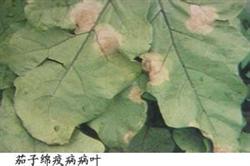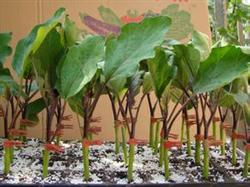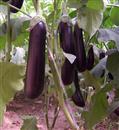Control of cucumber blight and eggplant cotton blight

The disease symptoms of cucumber blight can occur in both seedling stage and adult stage, and mainly harm the stem base, tender stem nodes, leaves and fruits of the plant at the adult stage. At first, dark green water stains appeared at the stem base and stem nodes, then softened, the stem nodes were significantly constricted and thinned, and the leaves above the diseased part wilted or the whole plant died. Leaves infected with the disease produce round or irregular water-immersed disease spots, the edge is not obvious, expand rapidly, when dry is bluish white, easy to break, when the disease spot extends to the petiole, the leaves droop. If the melon stripe is infected, it will show a water stain at the beginning, dark green, and gradually constricted and depressed. Sparse white mold grows on the surface when it is wet, which rotts quickly and gives off a fishy smell. Eggplant cotton blight mainly harms fruits, leaves, stems, flowers and other parts. The first disease occurred in the fruit near the ground, the fruit surface appeared water-immersed round spots, slightly sunken, the pulp became black-brown and rotten, easy to fall off, and when the humidity was high, the dense fluffy hyphae grew on the surface of the disease, and expanded rapidly, which was the characteristic of the disease. The sick fruit rotted quickly. The stem node infection was water-immersed at first, then it became dark green or purplish brown, the disease part was constricted, its upper branches and leaves drooped, and sparse white mildew appeared when the humidity was high. The leaves were injured, showing irregular or nearly round water-immersed light brown or brown disease spots, with obvious wheel lines, and moist disease spots with sparse white mold. The prevention and cure method strengthens the cultivation management to prevent disease mainly, supplemented by the chemical control. The main results are as follows: (1) choose local disease-resistant varieties. (2) grafting to prevent disease, Yunnan black seed pumpkin (cucumber) and desrubam (eggplant) can be used as rootstocks to graft with disease-resistant cucumber and disease-resistant eggplant, which can prevent blight, Fusarium wilt and root rot. (3) soil treatment in seedbed or greenhouse. Seedbed soil treatment: per square meter of seedbed soil (or per cubic soil), mix 8 grams (or 150 grams) of wettable powder with 77% more than 10 kilograms of fine soil and sprinkle 10 kilograms of fine soil on the seedbed (or spray 10 kilograms of water in each cubic soil. After spraying, put the soil into a burrow tray or nutrition bowl). Soil treatment in greenhouse: the soil was treated with soil purifier (lime nitrogen) and solar energy high temperature disinfection for 20 days before planting or direct seeding. Methods: after harvest, the plants and diseased bodies in the greenhouse were cleaned, and the soil moisture was required to be 60%, 70%, 75 kg of lime nitrogen per mu, plus rotten cow dung or livestock and poultry manure, evenly sprinkled with soil surface, cultivated land, ridging and film mulching. The film was uncovered 5 days before planting, and the transplanting was carried out after turning the ground for 2 times. (4) for chemical control, 77% of Douning wettable powder 600 times solution is required for planting, with 0.1 kg potion per hole. After returning to the seedling, the root can be irrigated with 77% Dorin wettable powder 600 times, and the stem base and soil surface can be sprayed with 72% Kelou wettable powder 800ml 1000 times, once every 15 days, or 2 Mel for 3 times depending on the development of the disease. At the same time, 6% Apollo 963 water agent 1000 times or 0.5% OS-Stirling water solution can be sprayed at the same time.
- Prev

Annual cultivation techniques of grafted eggplant
With the expansion of eggplant cultivation area and continuous planting, all kinds of soil-borne diseases are quite common, and the harm is becoming more and more serious, such as eggplant Verticillium wilt, Fusarium wilt, bacterial wilt and so on. In the old areas of eggplant cultivation, soil-borne diseases have become stubborn diseases that limit eggplant production. Conventional pesticides are not effective in control, and grafting has been overcome.
- Next

Key points of eggplant cultivation in Crown King
The characteristics of Guanwang No. 1: medium maturity, strong growth potential, plant height of about 75 cm, good plant upright. Heat resistance, strong disease resistance, wide adaptability, strong fruiting power, fruit length about 40cm, rough 2.5cm, peel purple bright, smooth thin soft, white flesh, good quality. Cultivation points: 1, local climatic conditions and.
Related
- Where is it suitable to grow horseradish in China? it is expected to see the middle altitude horseradish in Alishan.
- How to prevent tomato virus disease reasonably? (Control methods included)
- Many people like to plant towel gourd on the balcony. What are the main points of this method and management?
- What crops can chili peppers be mixed with?
- Fertilization techniques and matters needing attention in Tomato
- What are the grafting techniques for peach seedlings in spring?
- Harm and control methods of root swelling disease of Chinese cabbage
- What are the pests of sweet potatoes? How to prevent and cure it?
- Symptoms, causes and Control methods of navel Rot in Tomato
- The cause of "Cucumber rotten bibcock" in Farmers' planting Cucumber and its Control Plan

